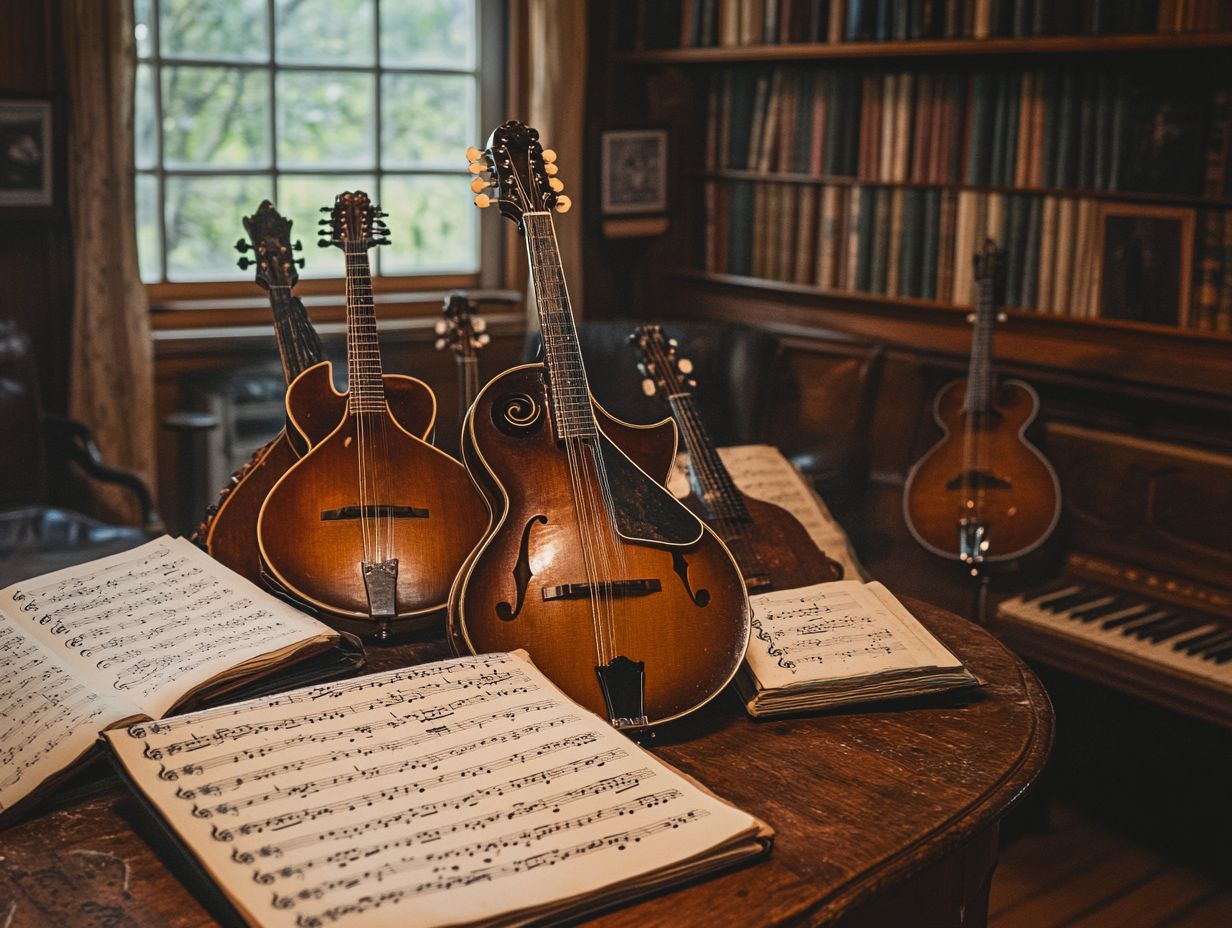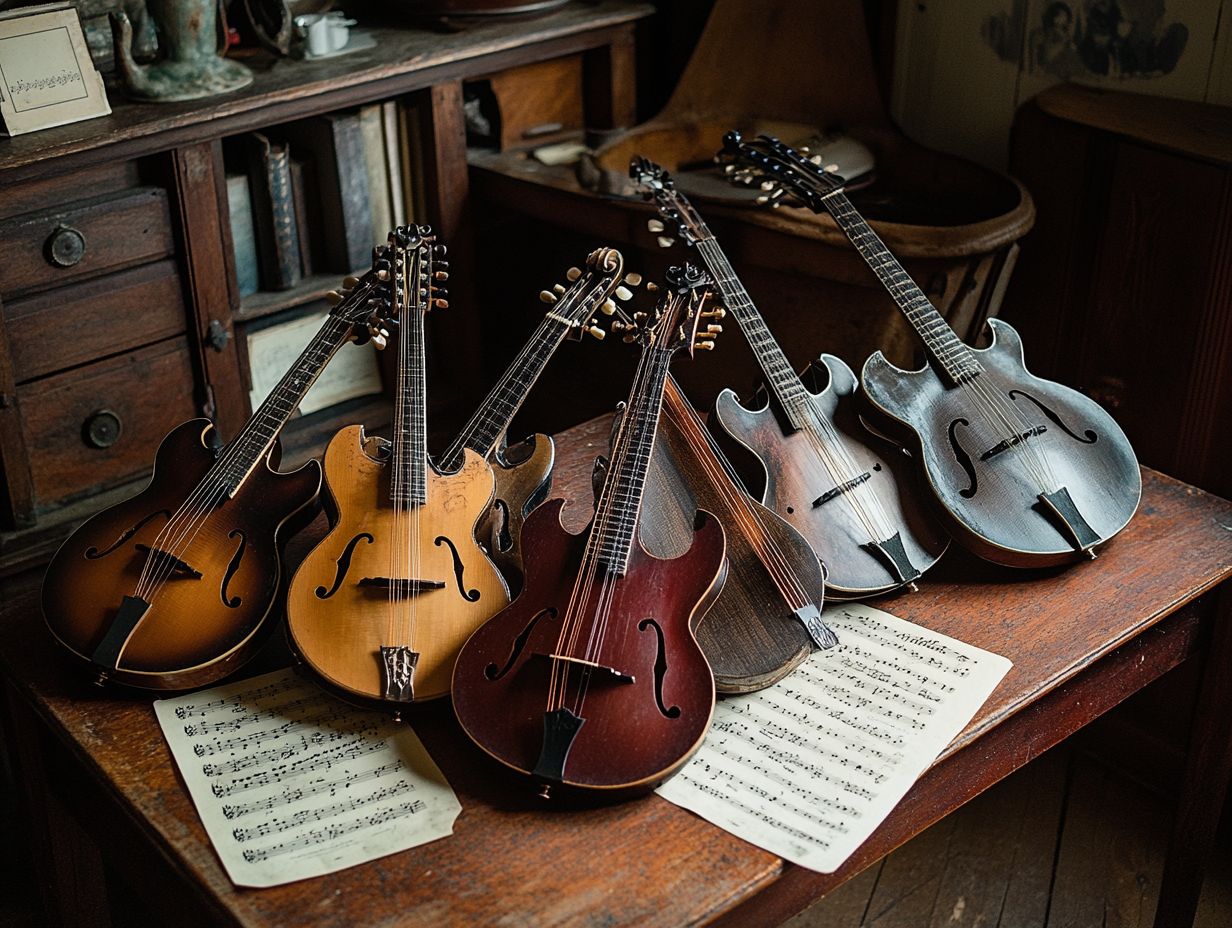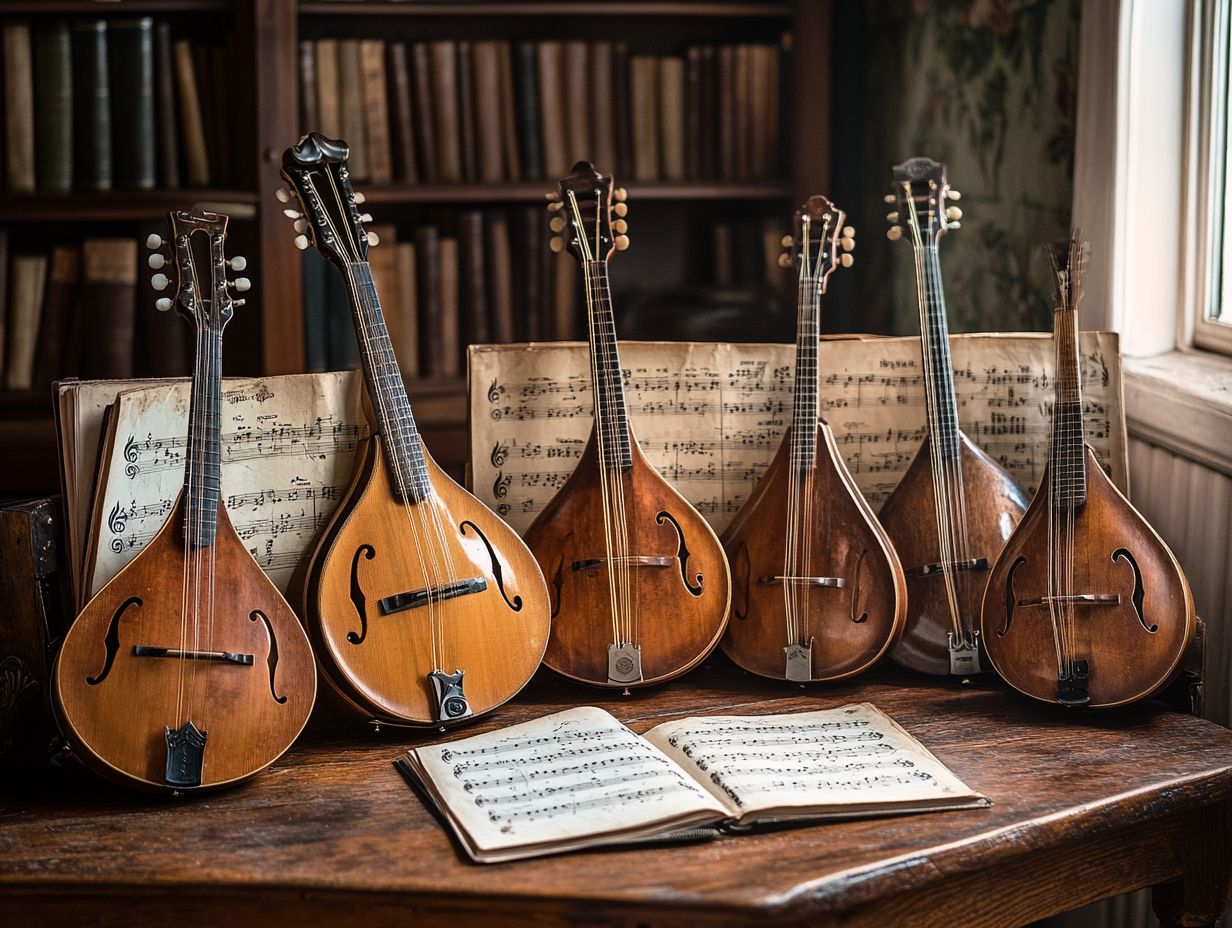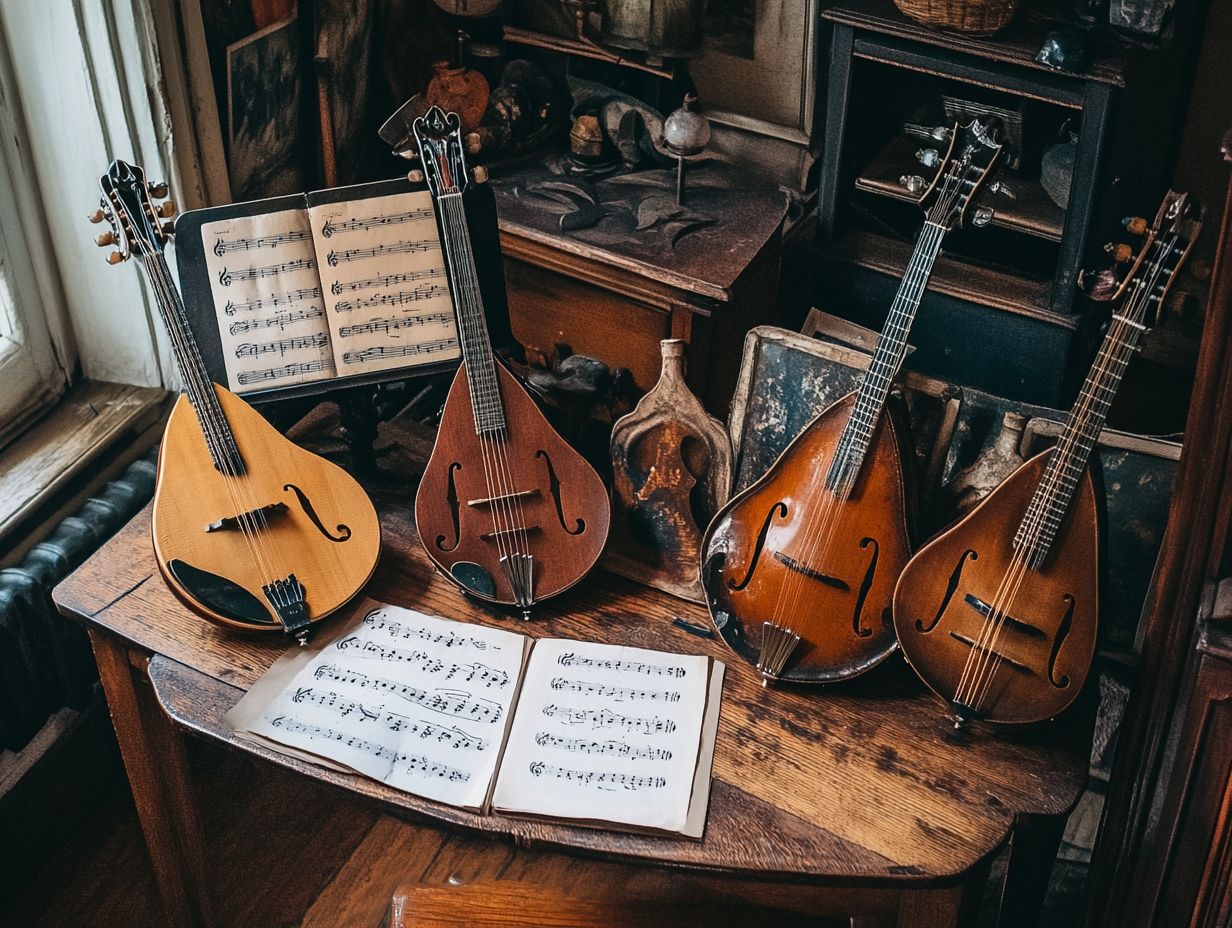The mandolin, known for its enchanting sound and rich history, has established a unique place in the world of music. From its classical roots and notable compositions to its vibrant presence in folk and bluegrass genres, this instrument has evolved beautifully over time.
In this exploration, we will trace the mandolin’s journey through various musical styles, highlight key players and techniques, and provide tips for choosing and caring for your own mandolin. Join us in celebrating the versatility and timeless appeal of this remarkable instrument.
Contents
History and Evolution of Mandolins

The history and evolution of mandolins can be traced back to their origins in the Renaissance. The craftsmanship and cultural significance of this unique string instrument have evolved through various genres, including classical, bluegrass, and folk music.
Over the centuries, the mandolin has undergone transformations, leading to its diverse applications in both solo performances and ensemble settings, particularly in Appalachian music and traditional folk gatherings. As the mandolin traveled across Europe and into the Americas, it absorbed influences from the various musical traditions it encountered.
The intricate craftsmanship involved in its construction—ranging from the selection of woods to the tuning methods—reflects regional styles and preferences. In Italy, master luthiers perfected the F-style mandolin, which contributed to its popularity in classical compositions. Meanwhile, in the United States, it became a staple in bluegrass and country music, showcasing its versatility.
Thus, the evolution of the mandolin reflects not only artistic innovation but also the blending of cultures through melody and rhythm.
Classical Music and the Mandolin
Classical music has adopted the mandolin as a distinctive instrument that enhances orchestral arrangements and chamber music performances with intricate melodies and harmonies. Its versatility and rich tonal qualities are showcased across a variety of classical repertoires.
Renowned composers have created compositions specifically for the mandolin, elevating its status in the music world and solidifying its place both within orchestras and as a solo instrument.
Notable Compositions and Performances

Throughout history, compositions for the mandolin have highlighted its ability to express emotions and tell stories through melodies and rhythms. Renowned composers’ works have been performed by distinguished artists and ensembles, solidifying the mandolin’s place in the realm of classical music.
These compositions showcase the mandolin’s unique timbres, ranging from bright and joyful to deep and melancholic, effectively conveying the complexity of human emotion. The iconic works of Vivaldi and Mozart have inspired contemporary musicians to explore the instrument’s versatility and expand its repertoire.
Modern interpretations by virtuosos incorporate diverse genres, fostering a cross-pollination that resonates with today’s audiences. Through skillful performances, artists deliver dynamic interpretations that not only celebrate traditional compositions but also push the mandolin into new territories within classical music, demonstrating the instrument’s capacity for both technical virtuosity and emotional depth.
Mandolins in Folk Music
The mandolin plays a significant role in folk music, particularly in traditional Appalachian folk music, where it serves as a primary instrument for storytelling and cultural exchange during social events and celebrations.
Its unique sound enhances the rhythmic quality of folk genres, fostering a sense of community and continuity in musical traditions that have been passed down through the years.
Influences on Folk and Traditional Music

The mandolin significantly influences folk and traditional music by enhancing the rhythm and melody of compositions and embodying the cultural importance of social gatherings and community celebrations associated with these traditions. Its versatility allows for various improvisational techniques and adaptations, making it suitable for multiple folk music genres.
The mandolin has long been a cherished string instrument, intricately woven into the fabric of music history, whether in intimate community settings or large festivals. Its unique tonal qualities complement a diverse range of styles, from bluegrass to Italian folk, showcasing the mandolin’s adaptability across various global musical traditions.
Artists often experiment with different techniques, resulting in stylistic variations that reflect their unique cultural backgrounds and experiences. This improvisational aspect not only keeps the music alive and evolving but also strengthens the connection between the artist and the audience, reinforcing the cultural heritage that the mandolin continues to represent in folk music today.
Mandolins in Bluegrass Music
The mandolin is a fundamental instrument in bluegrass music, playing a crucial role in providing both rhythm and melody that characterize the genre. Its unique strumming styles and intricate chord progressions further enhance its contribution.
Prominent players have mastered the mandolin’s capabilities, frequently showcasing their artistry in both solo performances and ensemble settings. This has solidified the mandolin’s essential presence in bluegrass bands and music festivals.
Key Players and Signature Techniques

Key figures in bluegrass music have utilized unique techniques on the mandolin to highlight its rhythmic and melodic capabilities, contributing to the genre’s dynamic sound and improvisational flair. Techniques such as flatpicking, fingerpicking, and distinctive strumming patterns have become signature elements that define the artistry of prominent mandolinists.
For example, renowned musicians like Bill Monroe and Sam Bush have expanded the possibilities of the mandolin, employing intricate tremolo effects and rapid-fire runs that mesmerize audiences. Monroe’s groundbreaking use of the mandolin as a lead instrument in bluegrass set a new standard, while Bush’s ability to blend traditional picking with jazz influences showcases the instrument’s versatility.
These artists incorporate elements such as call-and-response, improvisational solos, and syncopated rhythms, enriching the overall texture of the genre. Their innovative contributions not only elevate the mandolin but also inspire a new generation of players to explore its potential across various musical styles.
Mandolins in Modern Music
The mandolin is enjoying a resurgence in modern music, with contemporary artists from various genres, including pop and rock, embracing the instrument’s versatility and artistic potential.
As musicians explore different soundscapes and collaborate across genres, the mandolin’s role and expression in today’s music continue to evolve.
Contemporary Artists and Genres
Contemporary artists have embraced the mandolin, incorporating it into a diverse range of genres and musical styles, which has led to the creation of innovative recordings.
How to Choose and Care for a Mandolin
Craftsmanship, tuning pegs, and materials are all factors that influence the sound quality and playability of a mandolin, making it essential to choose the right instrument. Additionally, proper care and maintenance, including regular tuning and cleaning, help preserve the mandolin’s resonance and extend its longevity.
Factors to Consider and Maintenance Tips
When choosing a mandolin, several factors should be considered, including sound quality, craftsmanship, and the instrument’s tuning capabilities, as these elements all contribute to an optimal playing experience.
Regular maintenance practices, such as checking the tuning pegs and cleaning the instrument, are essential for ensuring longevity and consistent performance.
The choice of wood and construction techniques greatly influences the tonal characteristics and durability of the mandolin; players often find that solid wood models typically produce a richer sound compared to laminated options.
It is also crucial to examine the materials used for the fretboard and bridge, as these components can significantly impact playability and resonance.
Regular tuning not only ensures a harmonious sound but also affects the musician’s ability to perform at their best.
Additionally, storing the mandolin in a controlled environment can prevent warping and other damage, thus safeguarding its craftsmanship and enhancing its overall sound quality for years to come.
